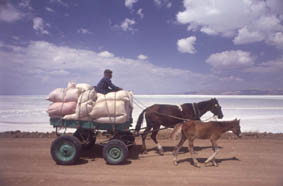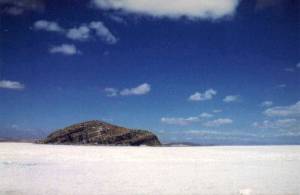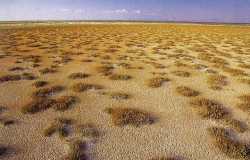Tuz Gölü (Salt lake)
 As you approach Şereflikoçhisar southeast
of Ankara, glinting light to the west tells you that the Tuz Gölü is approaching. The
intense whiteness and sparkle of the salt crystals look deceptively like snow and ice.
Even when you reach the edge, you still brace yourself for a freezing sensation as you
take off your shoes and socks. The first step is a surprise, at the second you adjust your
expectations, and at the third you become convinced that it is really salt beneath your
feet. And you start to think about salt, one of lifes most essential ingredients. Salt
makes up 3.5 percent of the human body, which is extraordinary testimony to the balance of
nature, because the proportion of salt in the worlds seas is also 3.5 percent! As you approach Şereflikoçhisar southeast
of Ankara, glinting light to the west tells you that the Tuz Gölü is approaching. The
intense whiteness and sparkle of the salt crystals look deceptively like snow and ice.
Even when you reach the edge, you still brace yourself for a freezing sensation as you
take off your shoes and socks. The first step is a surprise, at the second you adjust your
expectations, and at the third you become convinced that it is really salt beneath your
feet. And you start to think about salt, one of lifes most essential ingredients. Salt
makes up 3.5 percent of the human body, which is extraordinary testimony to the balance of
nature, because the proportion of salt in the worlds seas is also 3.5 percent!
 Wearing high rubber boots you can take a
long walk across the lake, if you do not mind sinking occasionally into patches of mud.
The water varies from a few centimetres to half a metre in depth most of the time, but
when the overflow from Lake Beyşehir pours through channels into Tuz Gölü, the depth
increases by 30-40 centimetres. When the water level rises, the ecological balance of the
lake is disturbed. Evaporation diminishes, and the circulation of the water between
atmosphere and ground becomes erratic. Wearing high rubber boots you can take a
long walk across the lake, if you do not mind sinking occasionally into patches of mud.
The water varies from a few centimetres to half a metre in depth most of the time, but
when the overflow from Lake Beyşehir pours through channels into Tuz Gölü, the depth
increases by 30-40 centimetres. When the water level rises, the ecological balance of the
lake is disturbed. Evaporation diminishes, and the circulation of the water between
atmosphere and ground becomes erratic.
 Tuz Gölü is fed by the Melendiz river,
several small streams, and underground salt water springs. Three salt pans in the lake
produce one million tons of salt a year, or 64% of Turkeys total requirements.
Saturated salt water is allowed to pour into the Kaldırım, Kayacık and Yavşan salt
pans, and when the salt has precipitated the water is drained off again. Then the salt is
shovelled into wagons which travel along an extensive network of rails to warehouses on
the lake shore. From here the salt is taken by truck to several privately owned salt
processing plants, mainly situated in Şereflikoçhisar. Here the salt is washed several
times, dried, and packed into sacks for distribution to factories all over Turkey. Tuz Gölü is fed by the Melendiz river,
several small streams, and underground salt water springs. Three salt pans in the lake
produce one million tons of salt a year, or 64% of Turkeys total requirements.
Saturated salt water is allowed to pour into the Kaldırım, Kayacık and Yavşan salt
pans, and when the salt has precipitated the water is drained off again. Then the salt is
shovelled into wagons which travel along an extensive network of rails to warehouses on
the lake shore. From here the salt is taken by truck to several privately owned salt
processing plants, mainly situated in Şereflikoçhisar. Here the salt is washed several
times, dried, and packed into sacks for distribution to factories all over Turkey.
In Ottoman times the blocks of salt which formed naturally around the lake were broken
up and sold to traders there on the lake shore. The salt was loaded onto camels and
carried off in every direction. In later years warehouses were built, and then a narrow
gauge railway was constructed to the lake, enabling salt to be gathered from different
parts of it each year. This continued until the 1970s, when the more efficient salt pans
in use today were constructed.
 With an
area of 1500 square kilometres, Tuz Gölü is Turkeys second largest lake, after Lake
Van. There are several new villages round the lake settled by people from different parts
of the country. Stock farming and agriculture are practised here, and around the shores
you are particularly struck by the fields of melons and watermelons. Despite the fact that
any object submerged in the lake waters for even a short time become covered with a crust
of salt, the melons grown close to the lake shores are wonderfully sweet. With an
area of 1500 square kilometres, Tuz Gölü is Turkeys second largest lake, after Lake
Van. There are several new villages round the lake settled by people from different parts
of the country. Stock farming and agriculture are practised here, and around the shores
you are particularly struck by the fields of melons and watermelons. Despite the fact that
any object submerged in the lake waters for even a short time become covered with a crust
of salt, the melons grown close to the lake shores are wonderfully sweet.
Numerous potteries here produce water jars which the craftsmen claim are made nowhere
else in Turkey or the rest of the world. Known as salt jars, they are made of clay mixed
with salt, The high level of evaporation which results causes the jars to act like
refrigerators, and water kept in them remains cold in the hottest weather. Sufficient clay
for 200 water jars is mixed with around 10 kilos of salt. If too much salt is added the
jars crack during firing, and if the proportion is too low the jars do not allow
sufficient evaporation and will not keep the water cool. While water stored in an ordinary
pottery jar remains fresh and sweet for just five or six months, when stored in a salt jar
it can apparently be kept without any deterioration of quality for four or five years.
A paved road, thought to date from Roman times, crosses the northern arm of the lake
from east to west, linking Şereflikoçhisar to Kulu near Haymana. Many of the marble
columns erected along each side of the submerged road to prevent the caravans from
straying off and getting stuck in the mud are still standing. Today, however, soil piled
on the road has raised it about one metre above the surface. On Büyükada Island in the
lake is a small church dating from late Roman times, and the remains of a guard house
which offered protection for travellers along the road and is thought to date from the
same period. Red standing stones scattered through the area are said by local people to
mark the graves of those killed during the First World War. There are also many ancient
burial mounds in the vicinity.
 Visitors touring Cappadocia often include Tuz Gölü in their
itinerary. It is indeed worth coming to see the strange sight of the salt gleaming like
silver beneath the clear lake water. When the coachloads of tourists stop on the lakeside,
no one can resist paddling on the salt bottom. Disregarding the splashes of water on their
skirts and trousers, they enjoy the sensation of wading through this unearthly white
world. And when the water splashes dry, a fine layer of salt is left behind as a reminder
of Tuz Gölü. Visitors touring Cappadocia often include Tuz Gölü in their
itinerary. It is indeed worth coming to see the strange sight of the salt gleaming like
silver beneath the clear lake water. When the coachloads of tourists stop on the lakeside,
no one can resist paddling on the salt bottom. Disregarding the splashes of water on their
skirts and trousers, they enjoy the sensation of wading through this unearthly white
world. And when the water splashes dry, a fine layer of salt is left behind as a reminder
of Tuz Gölü.
|